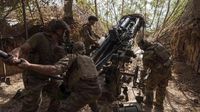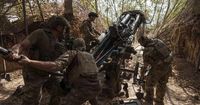In the weeks leading up to a high-stakes summit between Russian President Vladimir Putin and U.S. President Donald Trump in Alaska, the war in Ukraine has entered a perilous new phase. Russian forces have managed to breach Ukrainian defensive lines in the Donetsk region, Ukraine’s industrial heartland, at a time when Kyiv is also struggling to keep up with advances in Russian missile technology that are straining its air defense capabilities. The convergence of these battlefield developments and diplomatic maneuvers is raising alarm among Ukrainian officials and their Western allies, who fear that Moscow may seek to translate tactical gains into strategic leverage at the negotiating table.
According to the Associated Press, Russian troops advanced about 10 kilometers (6 miles) east of the coal-mining town of Dobropillia during a series of infiltrations on August 15, 2025. The breach, while described by analysts as a limited success for Moscow, has nonetheless put Ukrainian defenders on the back foot. Pokrovsk, a key highway and rail junction that once housed around 60,000 people, is now partially encircled, with Russian forces probing for weaknesses north of the city. The battlefield analysis site DeepState reported that the situation in this sector remains unstable, despite Ukrainian efforts to repel the attackers.
"The key risk for Ukraine is that the Kremlin will try to turn certain local gains on the battlefield into strategic victories at the negotiating table," said Mykola Bieleskov, a senior analyst at the CBA Initiatives Center, as quoted by the Associated Press. President Zelenskyy has made it clear that he views the timing of Russia’s advances as no coincidence, suggesting they are intended to create a sense of momentum for Putin in the American media space—just ahead of the Alaska summit with Trump. Zelenskyy also revealed that Putin is demanding Ukraine withdraw from the remaining 30% of Donetsk that Kyiv still controls as part of a proposed ceasefire, a demand the Ukrainian leader has categorically rejected.
Despite years of conflict, Russia does not fully control Donetsk, which it illegally annexed in 2022 along with the Luhansk, Kherson, and Zaporizhzhia regions. The recent Russian push has been characterized by small groups slipping past the first Ukrainian defensive line, exploiting a chronic shortage of Ukrainian infantry—a problem attributed to both stalled mobilization and poor management. A Ukrainian drone pilot, speaking anonymously to the Associated Press, described the breach as having felt inevitable for months. "We pay with territory and lives to fix mistakes — and we can keep fixing mistakes only as long as we have even a scrap of land left," he said.
To counter these infiltrations, Ukrainian forces have leaned heavily on first-person-view (FPV) drones—remotely piloted devices loaded with explosives that can strike targets up to 20 kilometers (about 12 miles) away. These drones have made areas near the front line deadly for both sides, but their effectiveness is limited by the Russians’ use of dispersed, small-unit tactics. "We can’t launch 100 FPVs at once," the drone pilot explained, noting that drone operators would interfere with each other if they tried mass launches. With both sides employing similar tactics and technologies, Russia’s superior manpower has become a decisive factor. "They have no regard for human life. Very often, most of those they send are on a one-way mission," Bieleskov noted.
Ukraine’s military has responded by redeploying additional troops to the most threatened sectors, including the battle-hardened Azov brigade. However, DeepState’s battlefield maps have yet to show any significant changes in favor of Ukrainian forces. Analysts warn that if the breach near Dobropillia is not contained, it could escalate into a wider crisis. The Russian strategy, according to Bieleskov, is to expand the breach into a corridor that will support their ground forces, avoiding direct assaults on heavily fortified urban centers. Instead, they are pushing through open terrain where Ukraine’s troop shortages make defense more difficult.
This approach threatens to bypass the city of Kostiantynivka, which had a pre-war population of over 67,000 but is now significantly ruined and on the verge of falling. If Russia manages to cut off supply routes to Kostiantynivka, defending the last major cities in the region—Sloviansk, Kramatorsk, and Druzhkivka—will become exponentially harder for Ukrainian forces. Cmdr. Serhii Filimonov of the "Da Vinci Wolves" battalion warned that Kostiantynivka could "fall without a fight" if supply lines are severed, describing the logistical challenges as "extremely difficult." Filimonov also expressed frustration over the diplomatic overtures to Moscow, stating, "And then the civilized world comes to them and says, ‘Fine, let’s make a deal.’ That’s not how it should be done."
While ground combat intensifies, Ukraine is also contending with a new wave of Russian missile attacks that are testing the limits of its air defenses. According to a recent assessment by the U.S. Defense Intelligence Agency, Russian advancements in ballistic missile technology—including enhanced maneuverability—are making it increasingly difficult for Ukraine’s American-made Patriot systems to intercept incoming threats. A Department of Defense Inspector General report cited specific incidents: On June 28, 2025, Ukraine managed to shoot down only one of seven Russian ballistic missiles; on July 9, it intercepted seven out of thirteen. These figures highlight a troubling trend as more Russian projectiles breach Ukraine’s aerial shield.
The Patriot missile system has been the backbone of Ukraine’s air defense, designed to counter advanced threats like the Iskander and Kinzhal missiles. However, as Russia upgrades its missiles, Ukraine’s ability to consistently employ the Patriots is being eroded. This not only affects the immediate conflict but also has broader implications for U.S. and NATO defense strategy. The Pentagon is closely monitoring Ukraine’s use of the Patriot systems to inform future air defense planning. At present, Ukraine operates at least six Patriot batteries provided by NATO allies, including the United States.
In response to the mounting missile threat, Ukrainian leaders have urgently requested additional Patriot systems and munitions. The U.S. has pledged to expedite military aid, working with European partners to bolster Kyiv’s defenses. Most notably, Germany has committed to sending two more Patriot batteries to Ukraine promptly, with further deliveries expected in the coming months. To ensure continued support, the U.S. has agreed to replenish German stockpiles of Patriots as part of a broader NATO effort to enhance Ukraine’s military capabilities.
These developments underscore the interconnectedness of battlefield realities and international diplomacy as the Alaska summit approaches. Ukrainian officials worry that even small Russian gains may be used as bargaining chips by Putin, who could argue that the war is going poorly for Kyiv and press Trump to pressure Ukraine into concessions. As the fighting grinds on and new technologies reshape the battlefield, the stakes for Ukraine—and for the broader security architecture of Europe—have rarely been higher.
The coming days will test not only Ukraine’s resilience on the front lines but also the resolve of its allies to provide the support needed to withstand both military and diplomatic offensives from Moscow.





